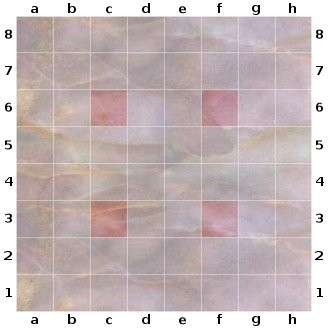Arimaa/Elephant and Camel Attacks/Objectives and Risks
< Arimaa < Elephant and Camel AttacksThe Elephant and Camel Attack is a powerful attack that commits the two strongest pieces against the same enemy trap. This attack is not frequently seen in practice due to the risk of a Camel hostage and the unbalanced distribution of forces. However, there are select situations where this attack can be used advantageously.
Note: For simplicity, many examples below will assume that the Gold player is attacking the c6 trap. Naturally, the same theories apply equally to attacks against all 4 traps.
Objectives
- Trap enemy pieces when the enemy Elephant is too far away to defend the trap.
- Create a wall with two strong pieces so that a Rabbit may be advanced along the outside.
- Distract the enemy Elephant from the opposite wing.
- Encourage a Camel hostage if the attacker believes the Camel hostage will be disadvantageous for the defender.
- Encourage a Camel hostage if the defender must lose piece(s) in order to take the hostage.
- Encourage a Camel hostage in order to attempt an Elephant blockade.
- Encourage a Camel hostage with the intention of swarming the trap with small pieces and releasing the attacking Elephant.
Note that some of the strategic objectives above can be achieved with a Lone Camel Attack.
Without question, the largest risk associated with the Elephant and Camel Attack is the risk that the Camel will be taken hostage. The defending Elephant often charges at an attacking Camel like a bull at a red cape. A position may become strategically lost for the attacking player if the Camel is taken hostage, and therefore advancing the Camel into enemy territory is not a decision to be taken lightly.

| |||||||||||||||||||||||||||||||||||||||||||||||||||||||||||||||||||||||||
| Diagram 1: Gold uses the two strongest pieces to open the path for a Rabbit advance | |||||||||||||||||||||||||||||||||||||||||||||||||||||||||||||||||||||||||
In diagram 1 to the right, Gold has taken full advantage of the unfortunate position of the Silver Elephant, which is decentralized and far removed from the northwest quadrant of the board. Seizing the opportunity to use an Elephant and Camel Attack, Gold has focused on pushing the Silver pieces east in order to clear a path for a Rabbit advance. Although Silver can temporarily stop the Rabbit from scoring, Gold can easily control the c6 trap and gain a large material advantage, or perhaps continue to press for a quick goal. As a general rule of thumb, it is preferable to place an attacking Elephant on d6 rather than c5 but the attacker should always consider the objectives in order to determine the optimal squares for the attacking pieces. In this case, the Elephant and Camel do very well on c5 and c7 and Silver will have a difficult time moving defenders to the a and b files. Note that if Gold did not have the Rabbit on a6, then Silver would be able to defend the position much more easily by playing a move such as rd6w dd3n md5n rd8w. The threat of goal will force Silver to play a move such as rd8w ce7n ce8w rc8w, allowing Gold to control the c6 trap with Ec5w Eb5e rb6s Ra6e.
Risks
- The Camel may be taken hostage. This situation is covered in detail later in the chapter.
- The Camel may be framed. This rarely occurs in practice and is not a disadvantage for the attacker if the Elephant is pinned to the d6 square.
- The Silver Elephant may stand on c5, stopping any trap threats from Gold’s two strongest pieces without decentralizing the Silver Elephant while also allowing the Silver Camel to operate on the opposite wing.
- Committing the two strongest pieces to the attack will leave Gold with weakened home traps.